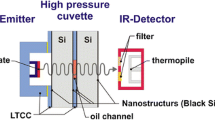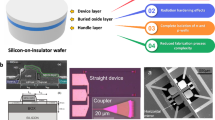Abstract
Thermal bonding of oxidized silicon wafers is used to obtain high-quality silicon on insulator (SOI) starting material for electronics and sensor applications. An overview of the technology is followed by a detailed description of the bonding technique and the ensuing wafer thinning processes for making SOI of various film thicknesses. Bonded pairs of wafers can be reproducibly produced free of contact voids. Thick-film SOI is produced using a simple bond and grind/polish technique. Thin-film SOI, suitable for CMOS applications, is produced using the bond and etch back (BE-SOI) process. A comparison of selective etch-back chemistry with different etchstop fabrication techniques is presented. These methods produce inexpensive, low-defect SOI, for integrated circuit applications, using materials and equipment common to silicon integrated circuit process lines.
Similar content being viewed by others
References
IEEE Circuits and Devices3, No. s 4 & 6 (1987): special is- sues overviewing the status of SOI research.
M. Kimura, K. Egami and M. Kanamori, Appl. Phys. Lett.43, 263 (1983).
T. Hamaguchi, N Endo, M. Kimura and A. Ishitani, Jpn. J. Appl. Phys.23, L815 (1984).
R. C. Frye, J. E. Griffith and Y. H. Wong, J. Electrochem. Soc.133, 1673 (1986).
M. Shimbo, K. Furukawa, K. Fukuda and K. Tanzawa, J. Appl. Phys.60, 2987 (1986).
J. B. Lasky, Appl. Phys. Lett.48, 78 (1986).
R. Stengl, T. Tan and U. Gösele, Jpn. J. Appl. Phys.28, 1735 (1989).
W. P. Maszara, G. Goetz, A. Caviglia and J. B. McKitterick, J. Appl. Phys.64, 4943 (1988).
R. D. Black, S. D. Arthur, R. S. Gilmore, N. Lewis, E. L. Hall and R. D. Lillquist, J. Appl. Phys.63, 2773 (1988).
C. Harendt, H.-G. Graf, E. Penteker and B. Höfflinger, Sen- sors and Actuators,23A, 927 (1989).
U. S. Davidsohn and Faith Lee, Proc. IEEE57, 1532 (1969).
J. B. Lasky, S. R. Stiffler, F. R. White and J. R. Abernathey, Digest of Techn. PapersIEDM-85, p. 684 (1985).
J. Haisma, G. A. C. M. Spierings, U. K. P. Biermann and J. A. Pals, Jpn. J. Appl. Phys.28, 1426 (1989).
E. Bassous and A. C. Lamberti, Microelectron. Eng.9, 167 (1989).
E. D. Palik, V. M. Bermudez and O. J. Glembocki, J. Elec- trochem. Soc.132, 135 (1985).
K. V. Ravi, Imperfections and Impurities in Semiconductor Silicon, pp. 161–173, Wiley-Interscience, New York (1981).
J. L. Vossen and W. Kern, Thin Film Processes, Chapter V-2, pp. 438–447, Academic Press, New York, (1978).
Author information
Authors and Affiliations
Rights and permissions
About this article
Cite this article
Harendt, C., Hunt, C.E., Appel, W. et al. Silicon on insulator material by Wafer Bonding. J. Electron. Mater. 20, 267–277 (1991). https://doi.org/10.1007/BF02651903
Received:
Issue Date:
DOI: https://doi.org/10.1007/BF02651903




